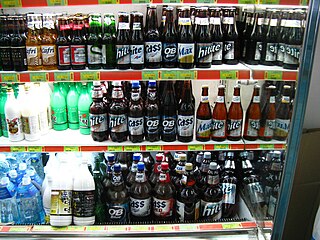
Craft beer is a beer that has been made by craft breweries. They produce smaller amounts of beer, typically less than large breweries, and are often independently owned. Such breweries are generally perceived and marketed as having an emphasis on enthusiasm, new flavours, and varied brewing techniques.
Beer in Africa, especially lager, is produced commercially in most African countries, and varieties of beer are also made by indigenous people. Beer is served in a range of locales, from neighbourhood shebeens to upscale bars. Many countries have standardized beer bottle sizes, which are cleaned and re-used, and so when buying beer at a store often people must pay a deposit on the bottle as well as the price of the beer. An alternative to glass-bottle beers is local beer sold in tetra-pak style paper cartons.

Beer in Japan mostly comes from the country's four major breweries, Asahi, Kirin, Sapporo and Suntory, which mainly produce pale lagers around 5% ABV. Beer is immensely popular, far ahead of sake consumption.

Beer, called maekju in Korean, was first introduced to Korea in the early 20th century. Seoul's first brewery opened in 1908. Two current major breweries date back to the 1930s. The third brewery established in Korea, Jinro Coors Brewery, was founded in the 1990s. It was later acquired by Oriental Breweries (OB). Hite Breweries's former name was Chosun Breweries, which was established in 1933. The company changed its name to Hite Breweries in 1998. OB Breweries established as Showa Kirin Breweries in 1933. The company changed its name to OB Breweries in 1995.
This article regards brewing in North Carolina.
Oldenberg is a German surname. Notable people with the surname include:
Oskar Blues Brewery is a craft brewery with locations in Longmont, Colorado, Brevard, North Carolina, and Austin, Texas. The company began as a brewpub in Lyons, Colorado in 1997 and began brewing beer in the basement in 1999. In 2002, they became one of the first to put their own craft beer in cans. In 2012, they began marketing some of their craft beer in resealable aluminum containers, and in 2012, they expanded and established another brewery in Brevard, North Carolina.

The U.S. state of Vermont is home to several breweries, microbreweries, nanobreweries, and brewpubs that produce a wide variety of beer.

The beers of the Caribbean are unique to each island in the region, although many are variants of the same style. Each island generally brews its own unique pale lager, the occasional stout, and often a non-alcoholic malta beverage. Contract-brewing of international beers is also common, with Heineken Pilsener and Guinness Foreign Extra Stout being the most popular. The beers vary between the islands to suit the taste and the brewing method used.

A brewery or brewing company is a business that makes and sells beer. The place at which beer is commercially made is either called a brewery or a beerhouse, where distinct sets of brewing equipment are called plant. The commercial brewing of beer has taken place since at least 2500 BC; in ancient Mesopotamia, brewers derived social sanction and divine protection from the goddess Ninkasi. Brewing was initially a cottage industry, with production taking place at home; by the ninth century, monasteries and farms would produce beer on a larger scale, selling the excess; and by the eleventh and twelfth centuries larger, dedicated breweries with eight to ten workers were being built.
The production of beer in New Jersey has been in a state of recovery since Prohibition (1919-1933) and the Great Depression (1929-1945). Currently, the state has 123 licensed breweries: a large production brewery owned by an international beverage company, Anheuser-Busch InBev, and 122 independent microbreweries and 19 brewpubs. The growth of the microbreweries and brewpubs since the 1990s has been aided by the loosening of the state's licensing restrictions and strict alcohol control laws, many of which were a legacy of Prohibition.

Porter is a style of beer that was developed in London, England in the early 18th century. It was well-hopped and dark in appearance owing to the use of brown malt. The name is believed to have originated from its popularity with porters.
The Nashville Brewing Company originally operated from 1859 to 1890 in Nashville, Tennessee. It was later renamed the Gerst Brewing Company and operated until 1954. The brewery was revived in 2016 by beer historian Scott R. Mertie, who had written a history of the Nashville brewing industry a decade earlier.
This page is based on this
Wikipedia article Text is available under the
CC BY-SA 4.0 license; additional terms may apply.
Images, videos and audio are available under their respective licenses.


















